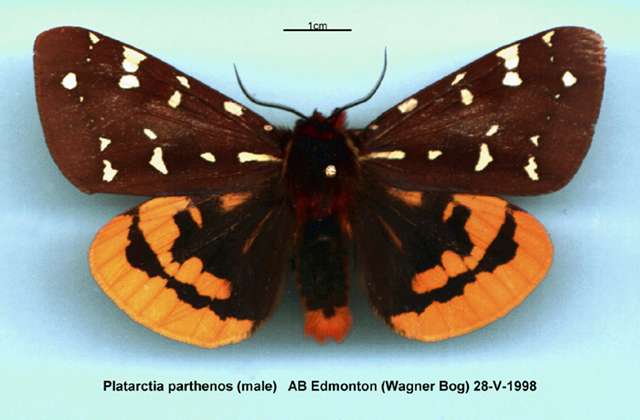« Back to your search
Species Details
Platarctia parthenos
University of Alberta E.H. Strickland Entomological Museum Read more about this collection »
Common NameSt. Lawrence Tiger
SeasonalityPeak activity from mid June to early July.
IdentificationOur largest tiger moth. Arctia caja and Pararctia yarrowi are superficially similar, but P. parthenos has greatly reduced white markings on the forewing, and the round hindwing spots of A. caja are absent in parthenos. The extent of the dark areas of the hindwing and light markings on the forewing can vary, and have been named as several 'varieties' (Brower, 1973).
D. Macaulay image
Scientific Name
Platarctia parthenos
Common Name
St. Lawrence Tiger
Habitat
Found in boreal mixed-wood and parkland habitats. Also occurs in moist, shrubby arctic tundra.
Seasonality
Peak activity from mid June to early July.
Identification
Our largest tiger moth. Arctia caja and Pararctia yarrowi are superficially similar, but P. parthenos has greatly reduced white markings on the forewing, and the round hindwing spots of A. caja are absent in…
Our largest tiger moth. Arctia caja and Pararctia yarrowi are superficially similar, but P. parthenos has greatly reduced white markings on the forewing, and the round hindwing spots of A. caja are absent in parthenos. The extent of the dark areas of the hindwing and light markings on the forewing can vary, and have been named as several 'varieties' (Brower, 1973).
D. Macaulay image
Life History
This species is semivoltine, overwintering first as a 5th instar and again as an 8th instar larva. Almost all Alberta and B.C. records for this species are from even-numbered years, suggesting it has a biennial phenology.
Conservation
Common.
Diet Info
P. parthenos have been observed on willows (Salix) and trembling aspen (Populus tremuloides). Also reported on alder (Alnus) and paper birch (McGugan, 1958). Successful lab hosts include snowberry (Symphoricarpos),…
P. parthenos have been observed on willows (Salix) and trembling aspen (Populus tremuloides). Also reported on alder (Alnus) and paper birch (McGugan, 1958). Successful lab hosts include snowberry (Symphoricarpos), Taraxacum, and Galium (Kimmich, 1966, Deschka & Hoffmann, 1986).
Range
From Labrador south to North Carolina, west to Alaska. South along the Rocky Mountains to Arizona.
References
Author
Deschka, G. and F. Hoffmann
Title
Die zucht von Platarctia parthenos (Harris 1850) unter Laborbedingungen.
Publication Date
1986
Series Title
Entomologische Zeitschrift
Volume
95
Pages
264-267
Author
Kimmich, H. P
Title
Notes on the biology of three Arctiid moths from British Columbia.
Publication Date
1966
Series Title
Journal of the Entomological Society of British Columbia
Volume
63
Pages
10-13
Author
McGugan, B. M.
Title
Papilionidae - Arctiidae
Publication Date
1958
Series Title
Forest Lepidoptera of Canada
Volume
1
Pages
76
Author
Schmidt, B. C.
Title
The tiger moths (Arctiidae) of Alberta.
Publication Date
2000
Pages
36
Author
Brower, A. E.
Title
Variations of Parasemia parthenos (Arctiidae).
Publication Date
1973
Series Title
The Journal of Research on the Lepidoptera
Volume
11
Pages
183-186
Specimen Information
There are 110 specimens of this Species.
BIRD35931 - Platarctia parthenos
University of Alberta E.H. Strickland Entomological Museum
Place CollectedCanada: Alberta, Winfield
Collected ByBird, C. D.
Date Collected2012-07-06
BIRD36826 - Platarctia parthenos
University of Alberta E.H. Strickland Entomological Museum
Place CollectedCanada: Alberta, Rimbey
Collected ByBird, C. D.
Date Collected2013-06-23
BIRD37540 - Platarctia parthenos
University of Alberta E.H. Strickland Entomological Museum
Place CollectedCanada: Alberta, Erskine
Collected ByBird, C. D.
Date Collected2014-06-22
BIRD37541 - Platarctia parthenos
University of Alberta E.H. Strickland Entomological Museum
Place CollectedCanada: Alberta, Winfield
Collected ByBird, C. D.
Date Collected2014-06-27
BIRD37542 - Platarctia parthenos
University of Alberta E.H. Strickland Entomological Museum
Place CollectedCanada: Alberta, Winfield
Collected ByBird, C. D.
Date Collected2014-07-12
